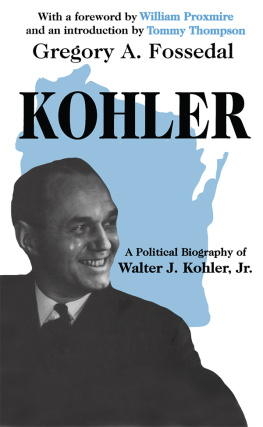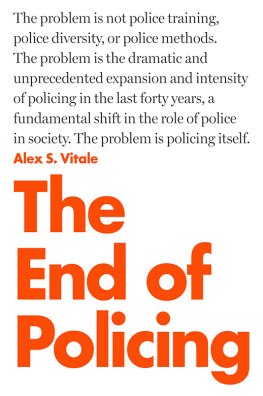MISDEMEANORLAND
Misdemeanorland
Criminal Courts
and Social Control
in an Age of
Broken Windows Policing
Issa Kohler-Hausmann
PRINCETON UNIVERSITY PRESS
PRINCETON AND OXFORD
Copyright 2018 by Issa Kohler-Hausmann
Requests for permission to reproduce material from this work
should be sent to Permissions, Princeton University Press
Published by Princeton University Press,
41 William Street, Princeton, New Jersey 08540
In the United Kingdom: Princeton University Press,
6 Oxford Street, Woodstock, Oxfordshire OX20 1TR
press.princeton.edu
Jacket design by Faceout Studio, Spencer Fuller
Excerpt from Police Strategy No. 5, 1994, published in the National Criminal Justice Service Reference and used with permission.
Excerpt from Norbert Elias, The Civilizing Process, vol. 2, State Formation and Civilization (1939; Oxford: Basil Blackwell, 2000), 366. With permission by John Wiley & Sons.
Excerpts from The Trial by Franz Kafka, translated by Willa Muir and Edwin Muir, translation copyright 1937, 1956, renewed 1965, 1984 by Penguin Random House LLC. Used by permission of Schocken Books, an imprint of the Knopf Doubleday Publishing Group, a division of Penguin Random House LLC. All rights reserved.
Parts of text appearing in have been previously published in the Stanford Law Review.
All Rights Reserved
ISBN 978-0-691-17430-3
Library of Congress Control Number: 2017959806
British Library Cataloging-in-Publication Data is available
This book has been composed in Adobe Text Pro and Gotham
Printed on acid-free paper.
Printed in the United States of America
10 9 8 7 6 5 4 3 2 1
MISDEMEANORLAND
ACKNOWLEDGMENTS
This project was made possible through interactions with people who work in or pass through misdemeanorlandsome by choice, some by force. I am thankful to all of themdefendants, attorneys, judges, court personnel, and otherswho took time to share their thoughts and experiences. It is no small thing to ask people who were just released from police custody or experienced an arrest to talk to a random lady in the hallway of the one place from which they are dying to escape and to which they hope never to return. And yet, that so many men and women did so is a testament to the fact that there are a lot of people who desperately want to share their thoughts on how the institutions that touch their lives and shape their communities ought to be run. Countless lawyers and court professionals extensively discussed their experiences and insights about New York Citys lower criminal courts. Not all will agree with all of my analysis and conclusions in this book; I can only hope that it will nonetheless instigate a meaningful conversation about how state power is used in this space.
Nor would this project have been possible without the support and guidance of the committee of scholars who were willing to take me on as a student during my years in graduate school at New York University. Jeff Manza has shaped and guided most of my adult academic life; he has been a patient and generous teacher, friend, and mentor. His encyclopedic knowledge of the field of sociology and sharp analytic mind pushed me to expand the ambitions of the project and refine the delivery of my work. He believed in me, encouraged me, and saw me through a lot. Graduate school involves a lot of ups and downs. I can only assume that even well-adjusted people are battered by the challenges of learning a discipline; trying to master methods, fieldwork, and writing; experiencing the inevitable sting of failures and rejections from grant applications and article submissions and resubmissions; entering the job market, and so forth. I certainly would have dropped out of graduate school many times over without his encouragement, and for better or for worse, he kept me in the game.
In the study of oft-neglected lower courts, Malcolm Feeleys work on misdemeanor courts is the giant upon whose shoulders I could only dream of hoisting my own work. I was not sure if I could succeed in reaching those shoulders, but his careful readings and incisive feedback on this project gave me the confidence to try to do so. My entire orientation to the fields of penal theory and history was shaped by being a student of David Garland, and his ideas have been formative in my approach to research since its inception. His ability to analyze broad themes and place my data in larger theoretical frameworks during our discussions has always been both exhilarating and intimidating. Lynne Haney showed much munificence and faith in taking me on as a student with my vague research plan and minimal experience as a qualitative researcher. I could not have done this project without her expert instruction in qualitative methods and patient coaching about how to move from micro observations to social theory. David Greenberg was an exceedingly generous teacher and promoter, sharing his understanding of the criminal justice world and research methodologies.
Beyond my committee, so many people at NYUs department of sociology were supportive and generous with time and feedback throughout my graduate school years. I cant list them all, but I want to extend special gratitude to Gabi Abend, Jen Jennings, Colin Jerolmack, Eric Klinenberg, Pat Sharkey, and Florencia Torche. Beyond NYU, Mitch Dunnier took me on as surrogate student, and his insights provided invaluable guidance. I also want to thank influential professors from law school, both from my first year at Northwestern and from two years at Yale, including Brett Dignam, Michael Gratz, Andrew Koppelman, Janice Nadler, Robert Post, and Dorothy Roberts. One person who might never know how important his interpersonal kindness and intellectual encouragement was to me at an incredibly sad and difficult time is Larry Marshall: you were always a model for the type of human and scholar I wanted to become. Al Klevoric was also an unbelievably influential mentor to me, encouraging and kind as a professor, patient at a collaborator, and nowluckily for mewonderful as a colleague.
NYU was a special place not just for the amazing professors, but also for the community of graduate students that fostered a lively and fun academic community (and the best parties at ASA). At the risk of leaving some people out, I want to acknowledge the many formative friendships and intellectual connections from this world, including my first officemates, Amy LeClair, Caitlin Petre, and Adaner Usmani, who were so supportive and hilarious in that tiny windowless roomand when we hustled our way into a windowed office, Jen Herwig and Ruthie Brownstein as well. I could not have survived those final years without those ladies. Max Besbris, Brian McCabe, Alison McKim, Mike McHulky (aka DS2/Mike Effx), Poulami Roychowdhury, Chris Seeds, and many other NYU graduate students: we all read each others work and bought each other drinks to numb failures or celebrate successes. I could not have asked for a better group of people to be young and broke with in New York City. I feel fortunate to also have had an extended community of scholars and friends, or scholar friends, in sociology and beyond whose work, support, or feedback have been formative, including Preeti Chauhan, Matt Desmond, Phil Goodwin, Jeff Lane, Josh Page, Michelle Phelps, Jeremy Travis, Nicole Van Cleve, Bruce Western, and others. I want to give a special thank you to those who read and commented on early versions of articles or chapters from this book. Megan Comfort has been an unbelievably inspiring force, as an intellectual model, political change agent, and wonderful friend. Armando Lara-Milln read and provided extensive comments on chapter 6, and his feedback and ideas were invaluable to my own thinking. To Sarah Brayne and Forrest Stuart: What do I say? You both read versions of this work when it was total garbage juice and helped me develop my own analysis and writing. My work has been deeply shaped by your research and writing, and I am beyond fortunate to have dear friends who are both really brilliant and really fun.







